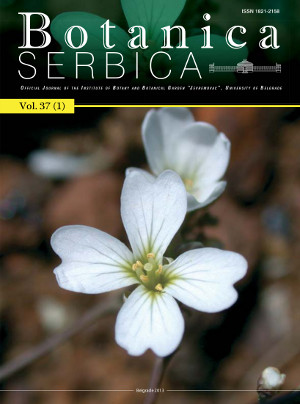
Volume 37 Issue 1 2013 |
Leaf anatomy of Carex humilis(Cyperaceae) from Central and South Eastern Europe
|
KEY WORDS: Carex humilis, C & SE Europe, leaf anatomy |
Are there arbuscular mycorrhizal associations in carnivorous plants Drosera burmanii and D. indica?
|
KEY WORDS: AM association, carnivorous plant, Drosera burmanii, Drosera indica |
Reproduction in the Sphacelariales: sex is a rare occurrence
|
KEY WORDS: Sphacelariales, life-history, reproduction, alternation of generations, Sp |
The Bryophyte Flora of Ancient Cities of Aydin Province (Turkey)
|
KEY WORDS: Bryophyte, Flora, Ancient Cities, Ayd?n, Turkey. |
Mires of Serbia - distribution characteristics
|
KEY WORDS: mire, peatland, peat, distribution, Serbia |
Histochemical, micromorphology and ultrastructural investigation in glandular trichomes of Micromeria thymifolia
|
KEY WORDS: Micromeria thymifolia, trichomes, histochemistry, micromorphology |
Ruderal flora and vegetation of the town of Žabljak (Montenegro) - an overview for the period 1990 - 1998
|
KEY WORDS: ruderal flora and vegetation, Žabljak, Montenegro |
Morphological differentiation and conservation status of Cardamine pancicii (Brassicaceae), a stenoendemic of Mt. Kopaonik in Serbia
|
KEY WORDS: Cardamine, endemic species, critically endangered species, distribution, Balkan Peninsula |
Reproductive Biology of the Balkan endemic Sideritis scardica (Lamiaceae)
|
KEY WORDS: Sideritis scardica, reproductive capacity, pollen viability |


